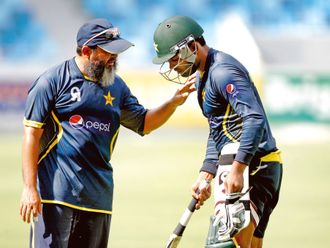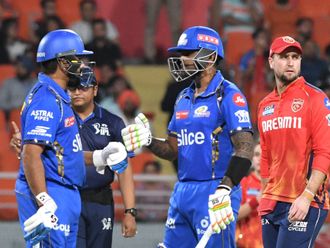London: When Matt Prior coolly blocked Trent Boult’s final delivery to secure an improbable draw in Auckland last Tuesday, a long winter’s work for the England side finally ended. Apart from three weeks in October and one week over Christmas and new year, the rolling caravan had been on the road since September 13. The team perhaps over-performed in the Tests in India and underperformed in the three in New Zealand, while doing no better than expected at the World Twenty20. Now, as home and away Ashes series loom, what are the biggest concerns?
ARE ENGLAND IMPROVING?
The good news is that England are in better shape than the Aussies; the bad news is that the gap between England and South Africa, the world’s best side, is widening. Two years ago the players were talking of becoming the best England team there had been but that has not happened - although in New Zealand they were perhaps guilty of thinking that it had, given the way they under-estimated the opposition. Since whitewashing India in 2011, England’s series results have been humdrum: lost, drawn, won, lost, won, drawn. Still, in 2009 they lost in the West Indies but went on to beat the Australians.
HOW WELL IS ANDY FLOWER’S JOB-SPLIT WORKING?
Flower is still awaiting his first win since handing over management of the one-day and Twenty20 sides to Ashley Giles. To measure him purely in terms of results would be harsh - he now has more time for long-term planning, which is definitely a benefit - but inevitably the fortunes of the two sides will be compared.
On that basis, Flower’s rein as Tests-only coach has begun shakily, even if fighting draws in Dunedin and Auckland suggest overall team spirit is good. Giving up one-day internationals didn’t work for Andrew Strauss as captain; we may find out more about how much Flower likes delegating after he has sat out June while the one-day teams are in action.
IS ALASTAIR COOK PRO-ACTIVE ENOUGH AS CAPTAIN?
If he did not have it already, Cook secured the loyalty of his players with three hundreds in India and a match-saving century in Dunedin. He held out an olive branch to Kevin Pietersen, too. But tactically he was cautious in New Zealand and was made to look more so by the ultra-positive Brendon McCullum. When New Zealand galloped towards a declaration on the fourth morning in Auckland, Cook looked lost for answers amid the carnage. Whether he has won the faith of his
bowlers is still unclear. Cook’s England are hard to beat but if a good team do not often make the running, it usually has something to do with leadership.
ARE ENGLAND TOO BEHOLDEN TO THE NUMBER-CRUNCHERS?
Cook’s decision to bowl first in Auckland began five days of struggle for England. McCullum said he would have done the same - and indeed opted to do so in the first two Tests. Only one of these three insertions proved wise. Research shows that batting first holds no great statistical advantage. Since 2003, 171 Tests have been won by teams batting second, 160 by those batting first. Teams who chose to bowl first won 54 and lost 43. Putting in the opposition has been made fashionable in the England camp by analyst Nathan Leamon. But Australia’s Ricky Ponting was one of the most successful captains of all time and he chose to bowl first only twice.
HOW IS KEVIN PIETERSEN’S REINTEGRATION GOING?
Pietersen soon made teammates glad to have him back with his tour de force in Mumbai. He appeared to mix well with the squad, though his departure from New Zealand before the final Test with what transpired to be a badly bruised knee may have raised some eyebrows. If a tour of New Zealand failed to stir his juices he would not be the first world-class player to face that problem. The management will be relieved he is not going to the IPL but he remains a man who marches to the beat of his own drum. He is England’s most attacking batsman and they need him; but he is 32 and nobody knows how long he will go on beyond next winter’s Ashes.
IS THIS ENGLAND’S BEST TOP SIX?
England’s batting continues to misfire in the first innings of overseas Tests, far more inexplicably in New Zealand than away to Asian opposition. Rain saved them in Dunedin and a combination of Matt Prior’s heroics, New Zealand’s errant catching and the shortcomings of their left-arm spinner Bruce Martin did the same in Auckland. Nick Compton (two hundreds, three failures) and Joe Root (six hours of resistance in the final Test but a series average of 17.5) remain works in progress. The selectors still have time to switch horses.
WHAT CAN BE DONE TO IMPROVE THE LOWER ORDER BATTING?
Stuart Broad’s stonewalling six from 77 balls at Eden Park should not disguise the fact that he has long forgotten how to build an innings in accepted fashion (first, play yourself in; second, expand strokeplay safely). He bats No 8 not because he warrants it but because Tim Bresnan and Graeme Swann are injured (Swann has usually batted below Broad but has the superior average since 2011). England miss the batting of both. The pitches in New Zealand were so somnolent that the likes of Broad and Steven Finn could survive long periods as batsmen but conditions won’t be so obliging in England or Australia.
IS JAMES ANDERSON’S FITNESS A CONCERN?
One could have got long odds against James Anderson smiling more in India than New Zealand. Conditions proved tough in both countries but the Indian challenge brought out the best in England’s spearhead whereas in New Zealand he simply became grumpy. He developed a stiff back bowling into the wind in Wellington and his left ankle played up, though that hardly explained why Trent Boult swung the ball conventionally more than Anderson did. At home he will get his hands on the Duke ball and the story could be very different. It had better be. The Ashes beckon.
WHY IS THE PACE ATTACK RUNNING HOT AND COLD?
England’s attack was once praised as the world’s best. Now it can’t hold a candle to South Africa’s. Much was expected in New Zealand and little delivered, not only because the pitches were disobliging.
Strangely, the standings of the frontline fast bowlers “flipped” during the New Zealand Tests: Anderson started on a high after India, as did Finn because of the menace he’d shown in the one-dayers, whereas Broad was feeling his way back from a heel injury; yet Anderson and Finn struggled to find rhythm while Broad in patches hit his best form. Neither is the back-up bowling pulling up trees: Chris Tremlett is not ready, Bresnan is in rehab and Graham Onions searching for form.
HOW LONG BEFORE GRAEME SWANN IS BACK TO HIS BEST?
England missed Swann’s inventiveness and energy in New Zealand; if he had been there when things went flat, he might have been able to conjure a wicket. His elbow surgery has gone well but rushing him back for the Tests against New Zealand in May could be viewed as a risk that is not worth taking. With careful handling he should be ready in plenty of time for the Ashes, in which he could make hay given Australia’s dangerously high number of left-handers. England need him fit because Monty Panesar’s shortcomings (with ball, if not bat) became more apparent as the Tests on non-turning New Zealand pitches went on.











